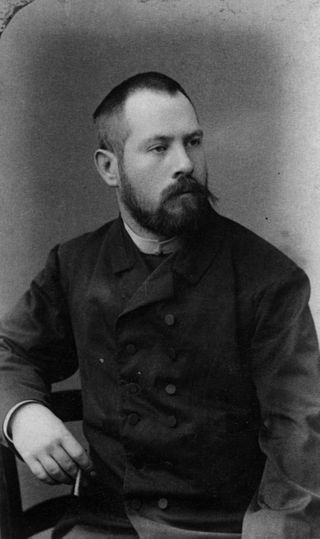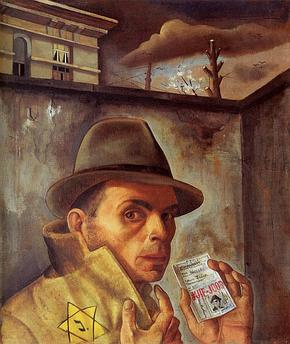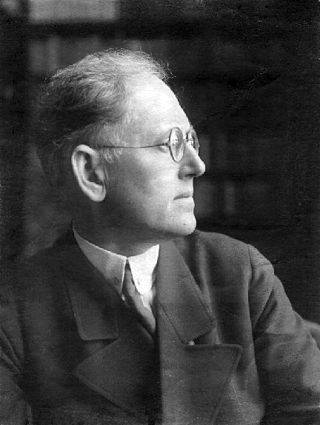Related Research Articles

Lovis Corinth was a German artist and writer whose mature work as a painter and printmaker realized a synthesis of impressionism and expressionism.

Wilhelm Maria Hubertus Leibl was a German realist painter of portraits and scenes of peasant life.

Felix Nussbaum was a German-Jewish surrealist painter. Nussbaum's paintings, including Self Portrait with Jewish Identity Card (1943) and Triumph of Death (1944), explore his experiences as a Jew during the Holocaust. His work is usually associated with the New Objectivity movement, and was influenced by the works of Giorgio de Chirico, Henri Rousseau, and Vincent van Gogh. He took refuge in Belgium after the Nazi rise to power, but was deported to Auschwitz along with his wife Felka Platek only a few months before the British liberation of Brussels on 3 September 1944.

The Academy of Fine Arts Vienna is a public art school in Vienna, Austria.

In art history, secession refers to a historic break between a group of avant-garde artists and conservative European standard-bearers of academic and official art in the late 19th and early 20th century. The name was first suggested by Georg Hirth (1841–1916), the editor and publisher of the influential German art magazine Jugend (Youth), which also went on to lend its name to the Jugendstil. His word choice emphasized the tumultuous rejection of legacy art while it was being reimagined.

Adolf Ziegler was a German painter and politician. He was tasked by the Nazi Party to oversee the purging of what the Party described as "degenerate art", by most of the German modern artists. He was Hitler's favourite painter. He was born in Bremen and died in Varnhalt, today Baden-Baden.

Paul Schultze-Naumburg was a German traditionalist architect, painter, publicist and author. A leading critic of modern architecture, he joined the Nazi Party in 1930 and became an important advocate of Nazi architecture.

Heinrich Hoffmann was Adolf Hitler's official photographer, and a Nazi politician and publisher, who was a member of Hitler's intimate circle. Hoffmann's photographs were a significant part of Hitler's propaganda campaign to present himself and the Nazi Party as a significant mass phenomenon. He received royalties from all uses of Hitler's image, which made him a millionaire over the course of Hitler's rule. After the Second World War he was tried and sentenced to 10 years in prison for war profiteering. He was classified by the Allies' Art Looting Investigators to be a "major offender" in Nazi art plundering of Jews, as both art dealer and collector and his art collection, which contained many artworks looted from Jews, was ordered confiscated by the Allies.

The Nazi regime in Germany actively promoted and censored forms of art between 1933 and 1945. Upon becoming dictator in 1933, Adolf Hitler gave his personal artistic preference the force of law to a degree rarely known before. In the case of Germany, the model was to be classical Greek and Roman art, seen by Hitler as an art whose exterior form embodied an inner racial ideal. It was, furthermore, to be comprehensible to the average man. This art was to be both heroic and romantic. The Nazis viewed the culture of the Weimar period with disgust. Their response stemmed partly from conservative aesthetics and partly from their determination to use culture as propaganda.

Conrad Hommel was a German painter. He was best known for his portraits of leading German entrepreneurs such as Max Grundig, Herbert Quandt, and politicians such as Adolf Hitler, Hermann Göring and Paul von Hindenburg.
Adolf Wissel was a German painter. He was one of the official artists of Nazism.

Karl Christian Ludwig Hofer or Carl Hofer was a German expressionist painter. He was director of the Berlin Academy of Fine Arts.

The Lenbachhaus is a building housing the Städtische Galerie art museum in Munich's Kunstareal.

Tegernsee is a town in the Miesbach district of Bavaria, Germany. It is located on the shore of Lake Tegernsee, which is 747 m (2,451 ft) above sea level. A spa town, it is surrounded by an alpine landscape of Upper Bavaria, and has an economy mainly based on tourism.

The Bavarian State Painting Collections, based in Munich, Germany, oversees artwork held by the Free State of Bavaria. It was established in 1799 as Centralgemäldegaleriedirektion. Artwork includes paintings, sculptures, photographs, video art and installation art. Pieces are on display in numerous galleries and museums throughout Bavaria.

Eduard Thöny was a German caricaturist and illustrator known for his work for the journal Simplicissimus, to which he was invited to contribute by Albert Langen. Born in Brixen, he studied at the arts academy in Munich. His work for Simplicissimus included more than 2,500 pages of cartoons used to lampoon German society and the military. Thöny's drawings would appear in the journal until it ceased publication in 1944.

Max Feldbauer (1869–1948) was a German painter, associated with the Munich Secession. He is primarily known for rural, Bavarian scenes.

Adolf Hitler, dictator of Nazi Germany from 1933 until his suicide in 1945, was also a painter. He produced hundreds of works when he tried to sell his paintings and postcards to earn a living during his Vienna years (1908–1913) but had little commercial success. A number of his paintings were recovered after the Second World War and have been sold at auctions for tens of thousands of dollars. Others were seized by the United States Army and are still in U.S. government possession.

Karl Walther was a painter of the German Post-Impressionist school, and an exponent of plein air painting. His works include portraits, still lifes, cityscapes and landscape paintings.

Karl Michael Haider (1846–1912), was a Bavarian landscape and portrait painter.
References
- ↑ Upi (1981-08-26). "Paul Padua, Artist, Is Dead; Known for Portrait of Hitler". The New York Times. ISSN 0362-4331 . Retrieved 2024-04-11.
- ↑ "Padua, Paul Matthias", in Hans Vollmer (coordinator), Allgemeines Lexikon der bildenden Künstler des XX. Jahrhunderts, K–P. E. A. Seemann, Leipzig 1956, p. 537 (German)
- ↑ Paul Mathias Padua, German Art Gallery
- ↑ Paul Mathias Padua, German Art Gallery
- ↑ Berthold Hinz, Die Malerei im deutschen Faschismus – Kunst und Konterrevolution, Hanser, Munich, 1974 (German)
- ↑ "Padua, Paul Mathias", in Theodor Kellenter, Die Gottbegnadeten: Hitlers Liste unersetzbarer Künstler, Kiel, Arndt, 2020 (German)
- ↑ Paul Mathias Padua, German Art Gallery